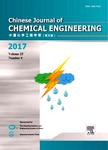Photocatalytic ozonation-based degradation of phenol by ZnO—TiO_(2)nanocomposites in spinning disk reactor
作者机构:Shanxi Province Key Laboratory of Higee-Oriented Chemical EngineeringSchool of Chemistry and Chemical EngineeringNorth University of ChinaTaiyuan 030051China Shanxi Sanqiang New Energy Technology Co.LtdTaiyuan 030051China
出 版 物:《Chinese Journal of Chemical Engineering》 (中国化学工程学报(英文版))
年 卷 期:2024年第72卷第8期
页 面:74-84页
核心收录:
学科分类:083002[工学-环境工程] 0830[工学-环境科学与工程(可授工学、理学、农学学位)] 08[工学]
基 金:supported by the National Natural Science Foundation of China(22208328) Fundamental Research Program of Shanxi Province(20210302124618,202203021212134)
主 题:Spinning disk reactor Photocatalytic ozonation ZnO-TiO_(2)nanocomposites Advanced oxidation processes
摘 要:Spinning disk reactor(SDR)has emerged as a novel process intensification photocatalytic reactor,and it has higher mass transfer efficiency and photon utilization for the degradation of toxic organic pollutants by advanced oxidation processes(AOPs).In this study,ZnO—TiO_(2)nanocomposites were prepared by solgel method,and coated on the disk of SDR by impregnation-pull-drying-calcination *** performance of catalyst was characterized by X-ray diffraction,scanning electron microscope,X-ray photoelectron spectroscopy,photoluminescence and ultraviolet—visible diffuse reflectance *** ozonation in SDR was used to remove phenol,and various factors on degradation effect were studied in *** results showed that the rate of degradation and mineralization reached 100%and 83.4%under UV light irradiation after 50 min,compared with photocatalysis and ozonation,the removal rate increased by 69.3%and 34.7%,and mineralization rate increased by 56.7%and 62.9%,which indicated that the coupling of photocatalysis and ozonation had a synergistic *** radical capture experiments demonstrated that the active species such as photogenerated holes(h^(+)),hydroxyl radicals(·OH),superoxide radical(·O_(2)-)were responsible for phenol degradation,and·OH played a leading role in the degradation process,while h+and·O_(2)^(-)played a non-leading role.



